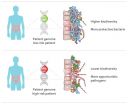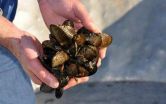(Press-News.org) DURHAM, N.C. - Duke University scientists have developed new forensic tracers to identify coal ash contamination in water and distinguish it from contamination coming from other sources.
"These new tools can be used by federal and state regulatory agencies to monitor the environmental effects of coal ash and determine whether it has or hasn't impacted the environment," said Avner Vengosh, professor of geochemistry and water quality at Duke's Nicholas School of the Environment. "They can be used to trace the coal ash effluents to their source, even in watersheds where there are multiple possible sources of contamination."
Previous methods to identify coal ash contaminants in the environment were based solely on the contaminants' chemical variations, he said. The newly developed tracers provide additional forensic fingerprints that give regulators a more accurate and systematic tool.
The tracers, which have been tested both in the laboratory and the field, are based on the distinctive isotopic and geochemical signatures of two elements, boron and strontium, found in coal ash effluent.
"The isotopic signature of boron coming from coal ash is always different from naturally occurring boron or boron from other sources," said Laura S. Ruhl, assistant professor of earth sciences at the University of Arkansas at Little Rock. "The signature of strontium is not always distinct, but when used together, the two tracers provide definitive evidence if the contamination is coming from coal ash or another source."
Ultimately, Ruhl said, she hopes the tracers can help companies and regulatory agencies identify safer ways to store and dispose of coal ash.
The study comes at a time when the U.S. EPA has submitted a proposal to the Office of Management and Budget to restrict coal ash disposal into the environment and, for the first time, establish federal regulations to govern how the ash is stored and disposed.
Vengosh and Ruhl published their findings this week in the peer-reviewed journal Environmental Science & Technology.
To test the tracers' reliability, the researchers conducted three types of experiments.
First, they collected samples of coal ash from three U.S. coal-producing regions - the Appalachian, Illinois and Powder River basins - and conducted lab tests to simulate what would happen in nature if the samples were leached and released into nearby waters. Each sample's leached solution was measured to characterize its isotopic fingerprints of boron and strontium.
Next, they collected effluents from coal ash facilities at power plants in North Carolina and Tennessee and compared it to both coal ash residue they had previously collected at the site of the massive 2008 Tennessee Valley Authority power plant spill in Kingston, Tenn., and to the laboratory test results.
The tests showed that the isotopic signatures of coal ash from all sources matched.
A third round of tests on water and sediment samples collected in lakes and rivers downstream from coal ash ponds in North Carolina yielded further confirmation. The tracers clearly showed that the fingerprints of boron and strontium in these samples matched the unique composition of coal ash and were different from those in samples from lakes and rivers unaffected by coal ash contamination.
"The tests confirm that we have generated new tracers that allow us to identify coal ash contaminants in the environment and delineate them from contaminants from other sources in the same watershed, including hydraulic fracturing," Vengosh said. "This is critical for protecting the environment and providing scientific evidence to help settle public debates on issues such as the environmental effects of coal ash or hydraulic fracturing."
INFORMATION:
Funding for the new study came from the National Science Foundation (grant #Cbet-1235661), Oak Ridge Associated Universities (grant #7-22975) and the Nicholas School of the Environment.
Vengosh and Ruhl's coauthors were Gary S. Dwyer and Heileen Hsu-Kim of Duke, and James C. Hower of the University of Kentucky. Ruhl received her PhD from Duke in 2012.
"Boron and Strontium Isotopic Characterization of Coal Combustion Residuals: Validations of New Environmental Tracers," Laura S. Ruhl, Gary S. Dwyer, Heileen Hsu-Kim, James C. Hower and Avner Vengosh. Environmental Science & Technology, Dec. 16, 2014.
http://dx.doi.org/10.1021/es503746v.
Washington, D.C.--New work from Carnegie's Ivan Naumov and Russell Hemley delves into the chemistry underlying some surprising recent observations about hydrogen, and reveals remarkable parallels between hydrogen and graphene under extreme pressures. Their work is the cover story in the December issue of Accounts of Chemical Research.
Hydrogen is the most-abundant element in the cosmos. With only a single electron per atom, it is deceptively simple. As a result, hydrogen has been a testing ground for theories of the chemical bond since the birth of quantum mechanics ...
MINNEAPOLIS/ST. PAUL (12/16/2014)--A new study by an international team of researchers shows for the first time that people may inherit some of the intestinal bacteria that cause Crohn's disease and ulcerative colitis, collectively know as inflammatory bowel disease (IBD). The study, recently published in Genome Medicine, also confirmed that antibiotics could worsen the imbalance in the gut microbes.
About 1.6 million Americans suffer from Crohn's disease or ulcerative colitis, according to the Crohn's and Colitis Foundation of America. Understanding the causes of these ...
AMHERST, Mass. - In a follow-up to her earlier studies of learning in infancy, developmental psychologist Lisa Scott and colleagues at the University of Massachusetts Amherst are reporting that talking to babies in their first year, in particular naming things in their world, can help them make connections between what they see and hear, and these learning benefits can be seen as much as five years later.
"Learning in infancy between the ages of six to nine months lays a foundation for learning later in childhood," Scott says. "Infants learn labels for people and things ...
WASHINGTON, DC--December 16, 2014--Using mathematical modeling, researchers at New York and Vanderbilt universities have shown that commensal bacteria that cause problems later in life most likely played a key role in stabilizing early human populations. The finding, published in mBio®, the online open-access journal of the American Society for Microbiology, offers an explanation as to why humans co-evolved with microbes that can cause or contribute to cancer, inflammation, and degenerative diseases of aging.
The work sprung from a fundamental question in biology ...
INDIANAPOLIS -- In the first real-world trial of the impact of patient-controlled access to electronic medical records, almost half of the patients who participated withheld clinically sensitive information in their medical record from some or all of their health care providers.
Should patients control who can see specific information in their electronic medical records? How much control should they have? Can doctors and other clinicians provide safe, high-quality care when a patient's preference may deny members of the medical team from seeing portions of the electronic ...
BALTIMORE, MD (Dec. 16, 2014)--With a unique, multi-faceted approach, researchers at the Lieber Institute for Brain Development (LIBD) have quantified the effect of previously unidentified anomalies in genetic expression that determine how the human brain develops from its earliest stages. Their work, published online December 15th in Nature Neuroscience, offers a novel technique for identifying biological markers in brain development that associate with risk for neurodevelopmental disorders such as schizophrenia and autism spectrum disorder (ASD).
Using state-of-the-art ...
The mortality of larval Pacific oysters in Northwest hatcheries has been linked to ocean acidification. Yet the rate of increase in carbon dioxide in the atmosphere and the decrease of pH in near-shore waters have been questioned as being severe enough to cause the die-offs.
Now, a new study of Pacific oyster and Mediterranean mussel larvae found that the earliest larval stages are sensitive to saturation state, rather than carbon dioxide (CO2) or pH (acidity) per se.
Saturation state is a measure of how corrosive seawater is to the calcium carbonate shells made by ...
Being "average" is often considered a bad thing, but new research suggests that averageness wins when people assess the trustworthiness of a face. The research indicates that, while typical-looking faces aren't seen as the most attractive, they are considered to be the most trustworthy. The new findings are published in Psychological Science, a journal of the Association for Psychological Science.
"Face typicality likely indicates familiarity and cultural affiliation - as such, these findings have important implications for understanding social perception, including cross-cultural ...
ITHACA, N.Y. - Since 1998, hundreds and sometimes thousands of dead eider ducks have been washing up every year on Cape Cod's beaches in late summer or early fall, but the reasons behind these cyclic die-offs have remained a mystery.
A team of scientists from Cornell, Tufts University, University of Georgia, the U.S. Geological Survey and the U.S. Fish and Wildlife Service have pinned down one of the agents responsible: a pathogen they're calling Wellfleet Bay virus (WFBV). Their findings shed light on why eider ducks (also called common eiders) die on Cape Cod every ...
NEW YORK, NY -- Researchers at NYU Langone Medical Center have developed new technology that can assess the location and impact of a brain injury merely by tracking the eye movements of patients as they watch music videos for less than four minutes, according to a study published Friday on-line in the Journal of Neurosurgery.
The study suggests that the use of eye tracking technology may be a potential biological marker for assessing brain function and monitoring recovery for patients with brain injuries.
Led by Uzma Samadani, MD, PhD, chief of neurosurgery at New ...





